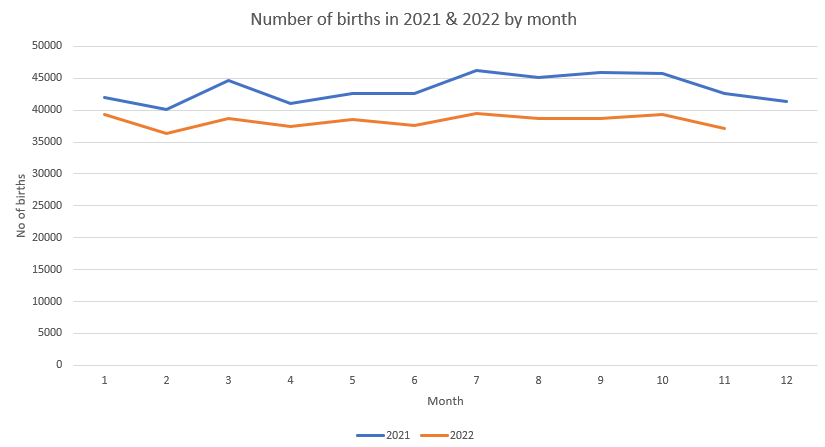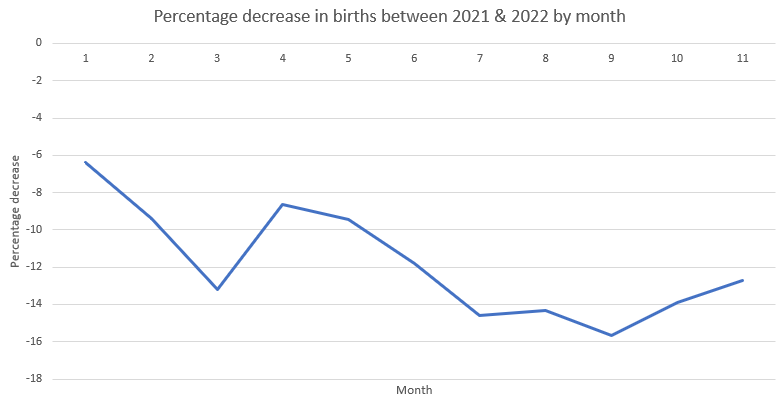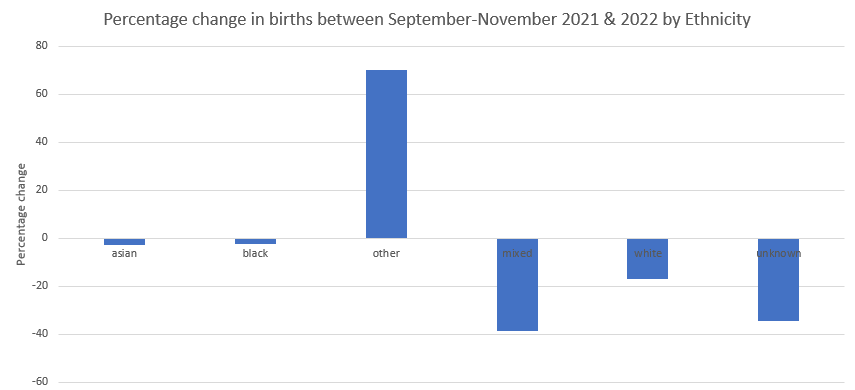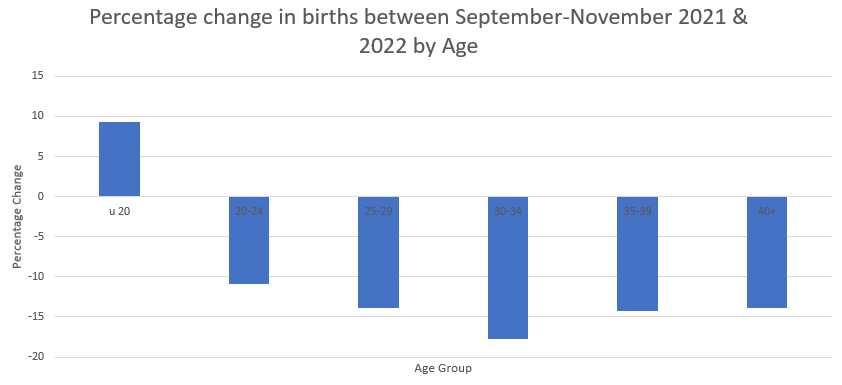Number of Births in England fall by 11.9% in 2022
A look at the latest vaccine surveillance report
After months of waiting, the UK Health Security Agency (UKHSA) has updated their ‘Vaccination in pregnancy’ tables in their ‘Covid-19 vaccine surveillance report’.
Many of us have been complaining that the tables have not been updated for over six months with the last set of data inputted in June 2022. Maybe they were working together with the ONS who updated their ‘deaths by vaccination status’ data last week. The UKHSA data has now been updated to November 2022. I don’t understand why there is still such a big delay but any update is better that nothing.
Previously, it has been noted that there were big drops in births when comparing 2022 with 2021. I can recall reading someone connected with the UKHSA or ONS saying that this was probably due to a data lag. Well the updated data are here and they are still as worrying as before. The updated data has slightly decreased the number of births in 2021 and slightly increased the number in 2022 but not by much.
As the data only runs until November 2022, I compared the number of women giving birth up to November 2021 with the number in 2022. In total between January and November there were 478,382 births in 2021 and 421,284 in 2022. 57,098 fewer births in 2022 which is a drop of 11.9%.
This next chart shows the percentage decrease in births by month. As you can see, the biggest decrease occurred in month 9 (September) with a decrease of 15.7%
The vaccine surveillance report’s own graph shows this drop. I have drawn a red line to show where the drop off starts, which coincidentally matches the peak of the first dose in pregnancy figures.
The report emphasises that there is nothing to worry about and that studies have shown the vaccine is safe in pregnancy. They present a number of graphs showing:
% of live-born babies at term without low birthweight;
% of live-born babies at term without low birthweight by age;
Stillbirths;
Low birthweights; and
Premature births.
Their graphs attempt to show that there isn’t much difference between vaccinated and unvaccinated mothers. However, in my opinion, these data don’t show much and could be considered disingenuous because they never compare with unvaccinated women. Instead they use the term ‘no doses in pregnancy’. This means instead of being a purely unvaccinated control group, women who were vaccinated before they were pregnant are lumped in the same group.
Next, I analysed the drop in births by ethnicity. I used the September to November 2021 data from the week 11 2021 vaccine surveillance report and compared with the September to November 2022 data in this latest report.
(A note to the UKHSA - your table columns are still labelled ‘April to June 2022’ whilst the table heading says ‘September to November 2022’. Clearly a cut and past job which doesn’t instil confidence with such an important data set.)
The report compares births in Asian, Black, Mixed, Other, Unknown and White women.
There is a big increase in ‘other’ births but in reality the difference is just a few thousand. The rest of the categories show drops ranging from -2.5% in black women to -38.7% in mixed race women. The vaccination rates at the time of delivery are as follows: Asian (75.9%). Black (53.9%), Mixed (62.1%), Other (64.9%), White (78%) and Unknown (58.9%).
So there is no clear pattern between percentage of women vaccinated and changes in number of births.
Next, looking at deprivation with 1 being most deprived and 5 the least deprived.
This time there is a clear pattern between deprivation status, vaccination status and decrease in births. Vaccination rates by deprivation status are as follows: 1 most deprived (63.7%), 2 (71.2%), 3 (77.8%), 4 (83.3%), 5 least deprived (87.2%).
Interestingly, the more deprived, the lower the birth rate drop. This is also coincides with a lower percentage of women vaccinated.
And finally by age.
Here the under 20s show an increase whilst the other age groups drop in number of births. The greatest drop is in the 30-34 year olds at -17.7%. Vaccination rates for this group are as follows: under 20s (46.8%), 20-24 (61.7%), 25-29 (69.8%), 30-34 (79.8%), 35-39 (82.7%), 40+ (81.8%).
Hopefully this massive drop in births can be explained by a data lag or maybe because there was a post lockdown bounce in 2021 so numbers dropped back down in 2022. However, if this was due to a data lag you would expect the drop to be consistent in the different categories highlighted above.
Perhaps the drop is due to the ‘cost of living crisis’ but then would you not expect the drop in numbers to be in poorer or younger women? Maybe it shows how the middle class are being hit the hardest?
But the effects of vaccination should not be dismissed and if I had the raw data I would want to look at this closer. The beginning of the drop coinciding with the peak in first vaccinations is worrying, as is the chart showing that the more wealthy and more vaccinated women are having fewer babies.










As a purely imaginary scientifc person or maybe as an imaginary investigative journalist or wannabe medical person, I will give my opinion with a lot of confidence and authority (why not? nobody in those positions for real appear to want to say anything)...
It is as clear as clear that the so-called vaccinations that women have been taking have caused them to not get pregnant. It is probable that the men they are partnered with are also taking these injections and are also failing to get them pregnant. They were all lied to about how safe these injections are. They all simply believed what they were told by people who also simply believed what they were told (albeit whilst wearing white coats and stethoscopes).
The evidence is clear to see from all around the world where people rushed to get these injections and kept going back for more. It should be up on billboards in Piccadilly Circus and Times Square! Because we here are all just talking to ourselves.
Excellent reporting. Many theories about these shots are difficult to prove definitively, but are scary enough to choose to skip the shots. The issue is with incentives. Those who regulate new pharma products should be barred by law from receiving any personal financial incentive, or incentive for their agency, either before, during or after their tenure in government. There should be a clear and defined wall. Furthermore, manufacturers of any product should have liability that can be proven or disproven in a court of law. Finally, no one should ever be forced or coerced into taking a product...if it works as advertised, then coercion won’t be necessary. As soon as those three mal-incentives are fixed, then the power people will stop assuming new products are safe until proven otherwise. Rather, they’ll revert to the historic precedent of assuming new products are dangerous until proven otherwise.